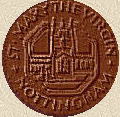 The History of the Parish Church
of St. Mary the Virgin, Nottingham.
The History of the Parish Church
of St. Mary the Virgin, Nottingham.
William Stretton - Hero or Villain?
Now we turn to the era of perhaps the most influential single architect and builder after the almost unknown constructor of the 14th century - William Stretton (1755-1828).
He
was a major contributor to the well-being of the church for a period
of some thirty years and probably among the great saviours of the
building. For instance, in 1811-1812, he inserted
the stucco vaulting into the tower of St. Mary's. Hood indicated that
Stretton was responsible also for the rebuilding of the north transept
end in 1799, and for a new front to the south
transept in 1818 "where in the eighteenth
century some flat-topped design had superseded the Gothic arch"
(see the previous page and Blackner's
illustration of 1815, also see below). Stretton certainly used stone
of a very high quality and his restorations, now cleaned, are very
little weathered. The villainy comes in when one realizes that he
added decoration where none should have been found, changing the style
from the original pure Perpendicular to something akin to the later
Decorated Perpendicular. This misdirection later led to the even more
exotic decorations of the Gilbert Scott design for the west front. The
works can be located on the Plan
Among Stretton's other works were the main park gateway of Wollaton Hall (1790); the Milton's Head, ?, in 1782, for himself as landlord; Newdigate's House in Friar Lane (1790); the Navigation Inn (right, but now renamed) by the canal on Wilford Street (1787); and Lenton Priory, his own residence, now enveloped by Nazareth House, Lenton. He was a churchwarden at St. Mary's and Lenton Priory (next door to his home and where he did excavations of the original Priory site), and was buried in Old Lenton churchyard. His father, Samuel Stretton built Colwick Hall and the new Grandstand on the Forest racecourse in 1776, both under the direction of Mr. John Carr of York (architect). In the churchyard there are slate tombstones in the churchyard by Stretton's. William Stretton was a churchwarden of St. Mary's from Easter 1802 to Easter 1806 and, it is interesting that he was the builder being paid for work done while he was holding office. He left many architectural and archaeological notes which were reprinted in 1910 (G.C. Robertson. The Stretton Manuscripts) and these include notes on his works and findings at St. Mary's. The descriptions of works which follow draw greatly on Stretton's manuscripts.
The Churchyard and the streets around
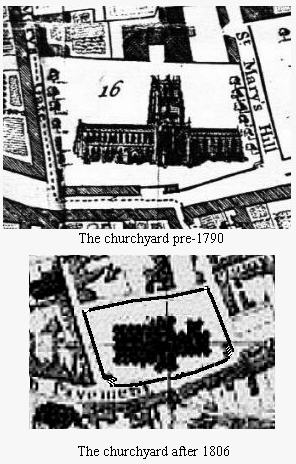 We
begin in 1790 with the start of quite dramatic
changes in the surroundings of the church. Rev.
Nathan Haines was still Vicar, staying so until his death on
27.4.1806. In 1790, however, Dr. Haines and others asked for a
grant of land to improve the south side of St. Mary's church,
including paving the Street. The first Mountsorrel Paving in
Nottingham was that from the Leen bridge up the Hollow Stone and to
the west end of St. Mary's church. Houses built upon St.
Mary's Church Wall were to be pulled down in order to improve
the Street. The Churchyard south-east corner was realigned to ease
alignment of main entrance to town from London road (prior to that all
coaches entering Nottingham from London had to make a sharp turn from
the top of Hollowstone).
We
begin in 1790 with the start of quite dramatic
changes in the surroundings of the church. Rev.
Nathan Haines was still Vicar, staying so until his death on
27.4.1806. In 1790, however, Dr. Haines and others asked for a
grant of land to improve the south side of St. Mary's church,
including paving the Street. The first Mountsorrel Paving in
Nottingham was that from the Leen bridge up the Hollow Stone and to
the west end of St. Mary's church. Houses built upon St.
Mary's Church Wall were to be pulled down in order to improve
the Street. The Churchyard south-east corner was realigned to ease
alignment of main entrance to town from London road (prior to that all
coaches entering Nottingham from London had to make a sharp turn from
the top of Hollowstone).
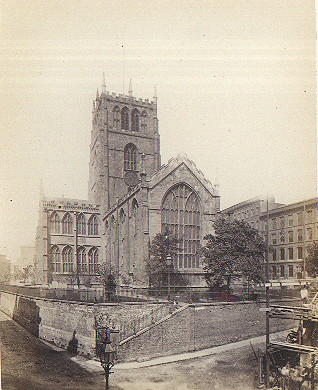 Between
1792 and 1807, the Churchyard was
walled around, with cast iron palisades and a gate at each corner; the
church accounts for 1806 included : Received "subscription for
fencing the church yard" - £199-3-8d. Expenditure included :
Mr Stretton paid for plans - £4-4-0d, Mr. Ashwell for iron
railing - £154-19-0d, Mr Stretton for churchyard wall - £253-3-0d,
Mr. Stretton for other work - £14-13-6d. Throsby reported the
widening of High Pavement by taking down houses and
the churchyard wall on the south side, and cutting away of part of the
churchyard. During this heavy rain led to a collapse and exposure of
several coffins. Chantry House belonging to the Bridge Estate was
pulled down as were "several little dwellings belonging to
the Vicarage", for which "the vicar receives forty
shillings a year from the parish as a remuneration"(Blackner).
Deering had related how The Chantry House was at "the
southwest corner, and close to the churchyard" and had been
given to the Corporation for repairing Nottingham Bridge (by Edward
VI). The road alongside the church was called "Church
Side" - the road comprising - Hollow Stone, Church
Side, High Pavement and Middle Pavement - was to be widened and
repaired to allow better access via Chapel Bar. At the end of the work
the southeast corner of the churchyard and road level was as today and
shown in the 1874 photograph (left).
Between
1792 and 1807, the Churchyard was
walled around, with cast iron palisades and a gate at each corner; the
church accounts for 1806 included : Received "subscription for
fencing the church yard" - £199-3-8d. Expenditure included :
Mr Stretton paid for plans - £4-4-0d, Mr. Ashwell for iron
railing - £154-19-0d, Mr Stretton for churchyard wall - £253-3-0d,
Mr. Stretton for other work - £14-13-6d. Throsby reported the
widening of High Pavement by taking down houses and
the churchyard wall on the south side, and cutting away of part of the
churchyard. During this heavy rain led to a collapse and exposure of
several coffins. Chantry House belonging to the Bridge Estate was
pulled down as were "several little dwellings belonging to
the Vicarage", for which "the vicar receives forty
shillings a year from the parish as a remuneration"(Blackner).
Deering had related how The Chantry House was at "the
southwest corner, and close to the churchyard" and had been
given to the Corporation for repairing Nottingham Bridge (by Edward
VI). The road alongside the church was called "Church
Side" - the road comprising - Hollow Stone, Church
Side, High Pavement and Middle Pavement - was to be widened and
repaired to allow better access via Chapel Bar. At the end of the work
the southeast corner of the churchyard and road level was as today and
shown in the 1874 photograph (left).
The two maps (above left) show the churchyard before and after all these works, with the removed houses, new gates and so-on. In brief, the Churchyard was enclosed by an iron palisade, with a gate at each corner and completed by July 1806; a road was taken off the north side which was before open to the church yard; the north and west wall then built, the East wall was built in 1804, and the South side with the paling in. The new road on the north side is known as Kaye's Walk and seems simply to have been made by paving the northern edge of the churchyard. When it was dug up in 1998, for electricity cables, interments were found under the paving. In the burials Register of St. Mary's, there appears Mr. Michael Kayes, 24.11.1778, with the footnote by Godfrey - he appears to have had a son, also named Michael, who married at St. Mary's, 6.4.1779, Ann Ward. "Kayes Walk, on the north side of the churchyard is probably named after this family".
While on the subject of roads, an Act of Parliament, dated 19th May 1796, was passed - "An Act for raising, maintaining, and keeping in repair, the road from the north end of the Old Trent-bridge to the west end of St. Mary's church-yard, by the way of Hollow-stone, in the town of Nottingham; and for erecting and maintaining such and so many floodbridges upon the said road, as may be necessary for widening and improving the entrance to the town". The final phase as regards the road was in 1801 when the section from the west end of the churchyard to the south end of Bridlesmith Gate was improved.
Structural works
 Inside
the church more work was afoot, in 1798/9 a "Glass
partition was run across the church, at the back of
the Quire". There was a lower glass screen to the organ loft
and an upper screen was added shortly after.
Inside
the church more work was afoot, in 1798/9 a "Glass
partition was run across the church, at the back of
the Quire". There was a lower glass screen to the organ loft
and an upper screen was added shortly after.
Then in 1799, the North transept end was restored, the window was renewed, and the interior walls were first coloured. At that time the colour was "yellow" but this was changed to "stone color" in February 1812 (when the groined ceiling was finished); John James churchwarden. Inside the church, in 1798-9, a "Glass partition was run across the church, at the back of the Quire".
Next, in 1800, Stretton wrote how the King's Arms were elegantly repainted (by Stretton's son, according to Hine) and ornamented on the groundwork of the old arms which were painted in fresco in the reign of Charles I (above the old vestry door and lost when a new organ was installed in 1872); John James and John Markland, churchwardens. In contrast, Blackner wrote how "the King's Arms were painted in a pompous manner over the vestry door, principally at the instigation of a man, whose whole conduct in life has been a manifestation of his, neither fearing God, nor honouring the King, but whose name shall not disgrace these pages". One has to conclude that Blackner was referring to William Stretton, as he makes no mention of Stretton by name, despite the latter being the builder who had overseen so much work at St. Mary's between 1792 and 1815 (when Blackner wrote).
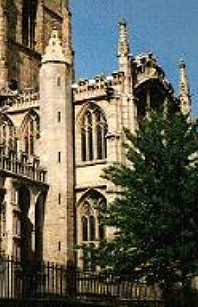 Then
in 1803, a Faculty was granted to remove the South
Transept monument to Lord Clare and to erect pews on its site (in the
south transept). The work was done in 1804, leaving only the memorial
panel still on the east wall of the South Transept. In 1804-5,
glazing was done, with someone named Cook being paid a total of £45-13-0d,
plus 7/4d paid to Mr. Greasley.
Then
in 1803, a Faculty was granted to remove the South
Transept monument to Lord Clare and to erect pews on its site (in the
south transept). The work was done in 1804, leaving only the memorial
panel still on the east wall of the South Transept. In 1804-5,
glazing was done, with someone named Cook being paid a total of £45-13-0d,
plus 7/4d paid to Mr. Greasley.
1808 was when a new clock was placed in front of the (organ) loft (possibly this is the clock now above the old chantry door in the north aisle).
In 1810, the Tower steps (right), door to belfry and new bell loft were built, plus the new Tower clock by Thomas Hardy, of Nottingham. The old south-facing dial had been taken down in 1807, the old clock "being nearly worn out", and the new clock had two faces, east and west, Blackner gave the cost as £126.
The next year, 1811, a "Cistern" was constructed at the "Back of St Mary's", 9.3 X 10.3 X 7.6 feet; James Severn and James Lacey, churchwardens. Quite what this was is not clear but perhaps it stored water for the two fire-engines.
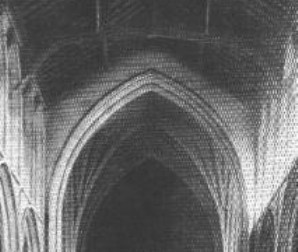 In
the two years, 1811-12, much internal work went on, with the
Tower ceiling, of oak wood and plaster stucco
(left); the old ringers' loft was removed, it had
been was built around 1660, with a staircase for access (perhaps that
off the chantry house, with newer south aisle access). The Parish
Register noted the "Bellfrey was taken down in Febry 1812,
Supposed to have been up about 104 years, and the Church restor'd to
its former Splendour", Chas Lacey Churchwarden.
In
the two years, 1811-12, much internal work went on, with the
Tower ceiling, of oak wood and plaster stucco
(left); the old ringers' loft was removed, it had
been was built around 1660, with a staircase for access (perhaps that
off the chantry house, with newer south aisle access). The Parish
Register noted the "Bellfrey was taken down in Febry 1812,
Supposed to have been up about 104 years, and the Church restor'd to
its former Splendour", Chas Lacey Churchwarden.
Other repairs of the time, still to be seen today, were several new Rainwater pipe tops with swan device (most on south nave), others on north chancel 1809, south chancel 1789.
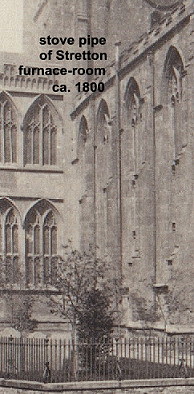 Stretton
described "St. Mary's Bone House, not so old as the Church,
tho it must have been built soon after it, the stile being exactly
corresponding with that of the Church, it was most probably a private
chapel or oratory - the present outward door was originally a window.
In 1815 the furnace for heating was
made under it." This is the "Chantry House"
with its original interior door off the north aisle. The exterior
after Stretton built an outward door (now opening westwards into the
kitchen corridor) is shown right, as it was in 1874. The other doors
now are from the north transept, which was opened only in 1942; and,
northwards, the north porch of 1889, from inside it is hidden behind
the cupboard. The Church annual report for 1922 related how the north
turret was "seriously decayed due to the flue of the the old
stove.
Stretton
described "St. Mary's Bone House, not so old as the Church,
tho it must have been built soon after it, the stile being exactly
corresponding with that of the Church, it was most probably a private
chapel or oratory - the present outward door was originally a window.
In 1815 the furnace for heating was
made under it." This is the "Chantry House"
with its original interior door off the north aisle. The exterior
after Stretton built an outward door (now opening westwards into the
kitchen corridor) is shown right, as it was in 1874. The other doors
now are from the north transept, which was opened only in 1942; and,
northwards, the north porch of 1889, from inside it is hidden behind
the cupboard. The Church annual report for 1922 related how the north
turret was "seriously decayed due to the flue of the the old
stove.
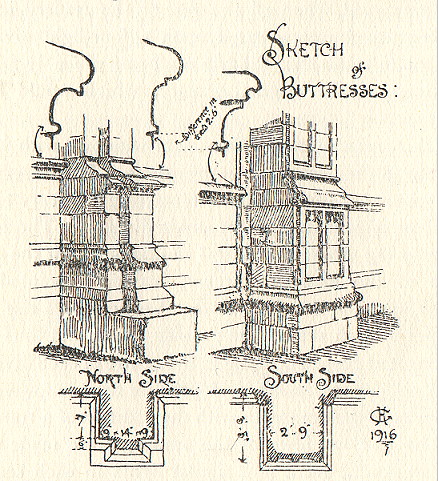 Perhaps
Stretton's final phase of major works started in 1812-4,
when the South side, "west of the aisle",
i.e. the transept, was refaced, replacing poor stone of 1761. He then
did the major reconstruction of the south transept - "where
in the eighteenth century some flat-topped design had superseded the
Gothic arch" (Stretton). Noteworthy is the dated gargoyle.
Orange, writing in 1840, described the "new buttresses, which
in a perversion of taste were added to the south transept, in 1818",
the style being "decorated English" and not true to the
original Perpendicular style.
Perhaps
Stretton's final phase of major works started in 1812-4,
when the South side, "west of the aisle",
i.e. the transept, was refaced, replacing poor stone of 1761. He then
did the major reconstruction of the south transept - "where
in the eighteenth century some flat-topped design had superseded the
Gothic arch" (Stretton). Noteworthy is the dated gargoyle.
Orange, writing in 1840, described the "new buttresses, which
in a perversion of taste were added to the south transept, in 1818",
the style being "decorated English" and not true to the
original Perpendicular style.
To his great credit, Stretton used high quality stone and his restorations have weathered well.
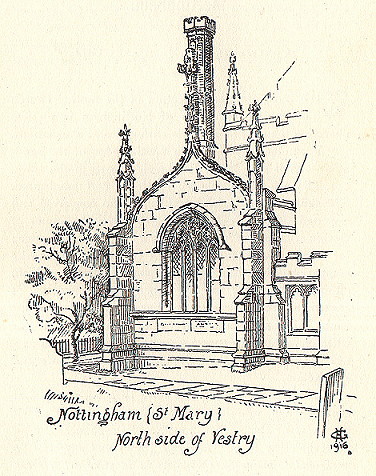 Similarly,
when the south front was rebuilt, by Stretton, the apex, later
replicated by Scott in the west front, was a simple triangular line,
albeit with castellation. The original ogee curve, shown in the 1677
etching, is still visible on the Vicar's vestry (which probably is
contemporary with the main body of the church, drawn by Harry Gill,
1916, right) and, if one looks carefully, on the top of the north
transept front (as drawn in 1844, below). Sadly, the ogee was missed or
ignored by Stretton and later, Gilbert Scott (perhaps, such a
construction would have been too expensive) and, so, the curve was not
revived on the south front nor, later, on the west front.
Similarly,
when the south front was rebuilt, by Stretton, the apex, later
replicated by Scott in the west front, was a simple triangular line,
albeit with castellation. The original ogee curve, shown in the 1677
etching, is still visible on the Vicar's vestry (which probably is
contemporary with the main body of the church, drawn by Harry Gill,
1916, right) and, if one looks carefully, on the top of the north
transept front (as drawn in 1844, below). Sadly, the ogee was missed or
ignored by Stretton and later, Gilbert Scott (perhaps, such a
construction would have been too expensive) and, so, the curve was not
revived on the south front nor, later, on the west front.
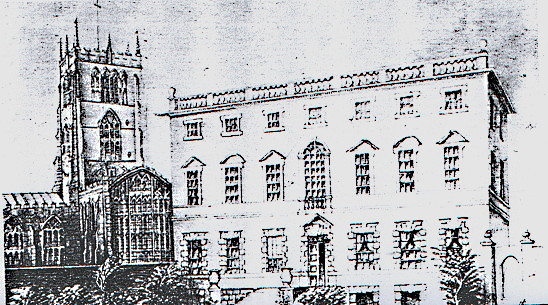
Ongoing life in and around the church
On February 25, 1792, between 8 and 9 pm, an "alarming shock of an earthquake " was felt in the Midlands, but particularly at Nottingham, many of the inhabitants running out of their houses. Later in the year, came the cutting of the first sod for the Nottingham Canal. This opened for navigation up to the town from Trent Bridge on July 30, 1793. An extension from the Poplar to Sneinton Hermitage was opened in 1835.
Another earthquake struck in 1795, when on November 18, at about 11 pm, the town and neighbourhood experienced a "severe shock of an earthquake; it was preceded by a noise resembling thunder, and its duration was about ten seconds. The shock was sufficiently violent to make the bells of the churches emit loud tones, as well as to overthrow a number of chimneys".
An Act of Parliament, dated 19th May 1796, was passed - "for raising, maintaining, and keeping in repair, the road from the north end of the Old Trent-bridge to the west end of St. Mary's church-yard, by the way of Hollow-stone, in the town of Nottingham; and for erecting and maintaining such and so many floodbridges upon the said road, as may be necessary for widening and improving the entrance to the town".
1797 was when the "Old Methodists" purchased land at the back of Mr. Fellows mansion on High Pavement to build a Chapel fronting on Halifax Place, and in 1798 church bells were rung to celebrate the news of Nelson's victory over the French in the Battle of the Nile - such celebrations were common at this time.
There clearly was an internal battle going on in the church as, on Easter Tuesday, in April, 1801, "the parishioners of St. Mary's revived their long dormant right of selecting a churchwarden alternately with the Vicar..... After a severe trial of strength, attended by gross irregularities, Mr. Mellor was elected" (Charles Mellor was the nominee of the "Church party" opposed by the "democratic section"). Locally, on September 26, "This morning at about 7 am, a stack of chimneys fell through the roof of the Old Angel public house, High Pavement, crushing one Sergeant Fairchild who was in bed below". Also, in November, the Independent Chapel in St. Mary's Gate was erected, through the seceders from the High Pavement chapel in 1761 being dispossessed of their chapel in Halifax Place. In 1861 the new chapel was turned into a shoeing forge.
In 1802, on May 7, the warehouse belonging to Messrs. Peet & Co. in Pilcher Gate caught fire. The two (fire) engines from St. Mary's church were immediately brought to the scene but to no avail. In the same year, William Stretton became Churchwarden. On November 17, occurred the death of Samuel Wise, Gent., of Beastmarket Hill, a musical composer of local eminence, and Organist to St. Mary's for 46 years, without interruption. Mr. John Pearson was appointed his successor.
A faculty was granted in 1803 to remove the monument to Lord Clare and to erect pews on its site (in the south transept), the work was done in 1804. In November of that year, the Weekday Cross was demolished. About the same time the St. Peter's churchyard was first enclosed. In the church in 1804-5, Glazing was done - one Cook was paid a total of £45-13-0d, plus 7/4d paid to Mr. Greasley.
The escalating population led to a public meeting being held on April 5, 1805, at Thurland Hall. D.P. Coke, Esq., was in the chair and it was unanimously resolved - "That, owing to the very great increase of inhabitants, a new church in the parish of St. Mary's, Nottingham, is indispensably necessary". Despite pledges of considerable sums of money (including £1000 from the potential incumbent, the Rev. John Burnett Stuart, and from others, including churchwardens, such as William Stretton, £500, and Charles Lacey, £200) the opposition of the Vicar and the Patron led to the plan being abandoned within a few weeks. On May 22, the Sexton, Mr. John Johnson, had died. A highly contested election ensued between with his son, John Johnson, supported by the Tory parishioners, and Mr. Thomas Clarkson, supported by the Whigs. Mr. Johnson won by 837 votes to 441.
On April 27, 1806, Rev. Nathan Haines, died, aged 70. By then he was Vicar of St. Mary's, a Prebendary of Southwell, rector of Cotgrave, perpetual curate of Sneinton, perpetual curate of Tong and domestic chaplain to Earl Manvers. He had resided at the High Pavement Vicarage for 35 years; and his remains were interred in the family vault under the High Altar at St. Mary's. Blackner, who obviously knew him, wrote of Haines "Though his mind was not expanded by the principles of philosophy, or by deep research into the liberal notions of theology, yet his conduct was peaceable, tolerant and friendly; and many poor families had to regret his death; for many were partly fed by his private bounty; nor did he vex his parishioners by a scrupulous extraction of tithes". As will be seen his successor was not of such a generous mind.
The Rev. Dr. John Bristow succeeded him as Vicar. Patron, Earl Manvers. Initially, the Registers were very badly kept, Bristow blaming a temporary Clerk. The long-standing Parish Clerk, Robert Kirkby, "Clerk of this Parish 48 years" and aged 81 when he died, was buried in St. Mary's on 26.2.1805. He had succeeded his father, John Kirkby who was Parish Clerk for near twenty years before his death on 23.9.1756, aged 66. Small brass plates in the south aisle mark where their bodies, and that of Ann, wife of Robert, who had died on 9.3.1788 aged 68, were interred.
From 1.9.1806, Mr. William Hough was Clerk and matters improved, however, Hough was Clerk for only 3 years 2 months and 19 days, from the entry recording his burial, on 21.11.1808. Godfrey, uncharacteristically wrote almost nothing about Bristow, not even whether he resigned or died in office, the Date Book tells us that he died in 1810. Noticeably, weddings in 1808-9 were conducted by others (e.g. Solomon Pigott & J. Staunton).
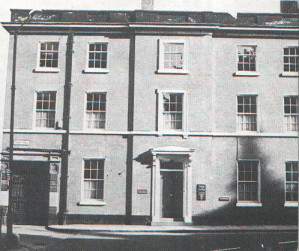 In
1807, on January 26, the Rev. Bristow called at
meeting of the ratepayers of St. Mary's, held in the vestry, at which
it was agreed to ask Parliament for a Bill to enable the parish to "erect
a house of industry for the reception of the poor of the parishes
within a radius of 12 miles". The meeting appears to have
been deliberately low key and the Bill would have passed but for the
dissolution of Parliament. On the 18th June, "the most
numerous vestry-meeting ever remembered by the oldest man living"
was opened in the vestry but moved to the west end of the church,
ending with a declaration against the proposal. Ultimately the ruinous
old poorhouse was enlarged and "patched in divers directions".
In
1807, on January 26, the Rev. Bristow called at
meeting of the ratepayers of St. Mary's, held in the vestry, at which
it was agreed to ask Parliament for a Bill to enable the parish to "erect
a house of industry for the reception of the poor of the parishes
within a radius of 12 miles". The meeting appears to have
been deliberately low key and the Bill would have passed but for the
dissolution of Parliament. On the 18th June, "the most
numerous vestry-meeting ever remembered by the oldest man living"
was opened in the vestry but moved to the west end of the church,
ending with a declaration against the proposal. Ultimately the ruinous
old poorhouse was enlarged and "patched in divers directions".
Blackner also related how, in 1808, Rev. Bristow sued Mrs. Haines to "recover damages, for her late husband's not having kept the house [the Vicarage, right] in a proper state of repair", although his claim was "very high" he obtained only £70. The front was "new modelled and stuccoed; and the whole interior also was put into a state of good repair".
On October 4, 5 & 6 1809, there was a "Grand musical festival, in St. Mary's Church, for the benefit of the General Hospital. The Grand Te Deum, by Handel, The Creation, and The Messiah were the principal performances; and amongst the vocalists were the celebrated Mrs. Billington, Miss Hawkins, Mr. Harrison, Mr. Pearson and Mr. Bartleman. Mr. Cramer was the leader of a full and efficient band, and Mr. Greatorex presided at the organ. The clear benefit to the institution was £509". On October 25, as part of the public celebrations of the Golden Jubilee of the reign of George III, a Civic service was held at St. Mary's.
In April 1810, the Rev. George Hutchinson, MA, was presented to the vicarage of St. Mary's, vacant by the death of the Rev. Dr. Bristow; Patron Earl Manvers. He was not very active publicly but the parishioners were growing in number, with baptisms rising to over 1,000 per year. Adding to this the marriages and burials, this shows the heavy workload on the incumbent and his one assistant curate. He died prematurely from a fall off his horse after only seven years. There is a memorial to Hutchinson in the church, he died on 15.10.1817, in the form of a small brass floor-plate in the north transept. In October 1810, a new church was opened at Sneinton (replaced "by the present structure (as at 1879) in 1839").
March 11, 1811, is the day recognized as the start of the "protracted and most alarming series of outrages, known as the 'Luddite disturbances'". These arose from the wide poverty associated with the introduction and rapid spread of knitting frames, and a drop in wages paid to the workers. The chaos continued for somewhat sporadically until at least 1817, with frame-breaking occurring across the whole of the Midlands and North. In 1812 an Act was passed making it a capital offence and on March 1, there was "the very unusual sight of the military attending Divine service with fixed bayonets", the reason being an anticipated attack on the County Gaol to liberate captured framebreakers). On August 7, Mr. Alderman William Wilson, of Plumptre House, was appointed Mayor. On October 10, he together with the Corporation in full costume processed from the County Hall to St. Mary's for Divine service to commemorate the opening of the General Lunatic Asylum, near the town. On April 27, an attempt was made, at 10.15 pm, to murder Mr. William Trentham, senr., an "extensive" hosier of this town. He was returning to his residence, a very ancient mansion at the southwest corner of Kaye's Walk. This seems to be one of the earliest reports of the new "walk" by name, in the Borough records (RBN VII) and the Parish Registers, the Kayes family are extensively mentioned, but not "Kaye's Walk".
In 1813, eleven Quakers were recorded as having "refused to pay an Assessment to the Repairs of the Church of St. Mary's". A disastrous fire broke out on the premises of Mr. Alderman Coldham, solicitor, and Town Clerk, in Halifax Place". Fortunately, Mr. Coldham was fully insured, being himself the local agent of the Phoenix office. Mr. Coldham was killed in a carriage accident on September 18, 1815, at Brighton, and a tablet in his memory is in the north aisle of St. Mary's.
On March 17, 1815, "Nottingham, in common with a great part of the North Midland District, experienced a smart shock of earthquake. It was felt at half-past twelve p.m., and as Divine service, it being Sunday, was not over at the churches, great alarm was expressed by the congregations. At St. Peter's and St. Nicholas's, the consternation was so great that service had to be suspended for a few seconds, and one lady was borne out in a state of insensibility. The pillars at St. Mary's shook very visibly, but fortunately the attention of the crowded congregation was so engrossed by the eloquence of the Sheriff's chaplain, and the presence of the Judge and his retinue, that the alarm was but slight, or the rush and loss of life might have been great". Hine, writing in 1876, has this as in 1816, adding the "The pillars in St. Mary's tower were visibly shaken".
1816 was the year of the death of John Blackner, author of a History of Nottingham. The Borough Records for the next year, 1817, reported the decision to erect a monument to George Coldham (Town Clerk) to be "on the wall in the Chancelof St. Mary's Church"; this monument is now in the north aisle.
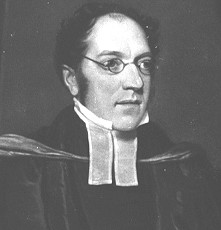 In
October 1817, the Rev. George Wilkins,
DD, was presented to the vicarage of St. Mary's, vacant by the death
of the Rev. G. Hutchinson. Hood recorded that there was a portrait of
Wilkins (right) in the Vestry. In 1832, he became an Archdeacon; in
1843, he resigned from St. Mary's; and on 13.8.1865, he died at
Southwell, aged 80.
In
October 1817, the Rev. George Wilkins,
DD, was presented to the vicarage of St. Mary's, vacant by the death
of the Rev. G. Hutchinson. Hood recorded that there was a portrait of
Wilkins (right) in the Vestry. In 1832, he became an Archdeacon; in
1843, he resigned from St. Mary's; and on 13.8.1865, he died at
Southwell, aged 80.
On November 22, 1818, the General Baptist Chapel in Broad Street was opened.
In 1819, on April 13, came the public introduction of gas lighting in the town. Only ten lamps were lit the first few days - one at the top of Drury Hill, another at the summit of Hollow Stone, five in Bridlesmith Gate (then the most fashionable shopping street in the town), and three in front of the Exchange.
1821, saw the Coronation of George IV (who had succeeded his father the previous year, and reigned until 1830). In the morning, St. Mary's Church was attended by the Mayor and Corporation, and an extremely numerous congregation.
The same morning, the foundation stone of St. Paul's chapel-of-ease was laid, "with the usual ceremonial, by the Reverend George Wilkins". The architect was William Wilkins, AM, FAS, and Mr. Spicer Crowe, builder; both appointed by "his Majesty's Commissioners for building and promotive of building additional churches" by whom the expenses of the structure and the ground on which it stood was defrayed from the Parliamentary grant. The chapel was consecrated on October 24, 1822, by the Archbishop of York, assisted by the Rev. Wilkins. The chapel was built on what had once been "Gregory's Paddock" (?corner of Broad Street and Back Side in the 1744 map) and by 1825 this small piece of land had on it five places of worship - St. Paul's, George St. Particular Baptist, Broad Street General Baptist, Parliament Street Methodist New Connexion, and a Roman Catholic Chapel (opened July 23, 1828). Wilkins who was an ardent antagonist of the division of parishes (with resultant loss of income and of control) was happy with St. Paul's as a chapel-of-ease. It was demolished in 1925.
In July 1826, a severe drought so lowered the river Trent that the underside could be extensively examined. "Under and above the sixth arch from the north end, a number of pieces of sculptured stone were found, some of which were beautifully wrought mullions of windows. These remains doubtless belonged to the ancient chapel of St. Mary's, which was built on the bridge, and were precisely of the same shape as the mullions of the upper windows of St. Mary's church, a portion of which is now (July, 1879) in the garden of Bromley House". This may provide a sensible alternative to the story of a mullioned window "from St Mary's" being in the wall of the Lace Market factory in Broadway.
In 1827 (& 1830), Prayer and Hymn Books were to be purchased for the use of the Corporation in the church.
The era ends in 1828, when William Stretton, "Architect and Surveyor to the Corporation and the Duke of Newcastle" died.